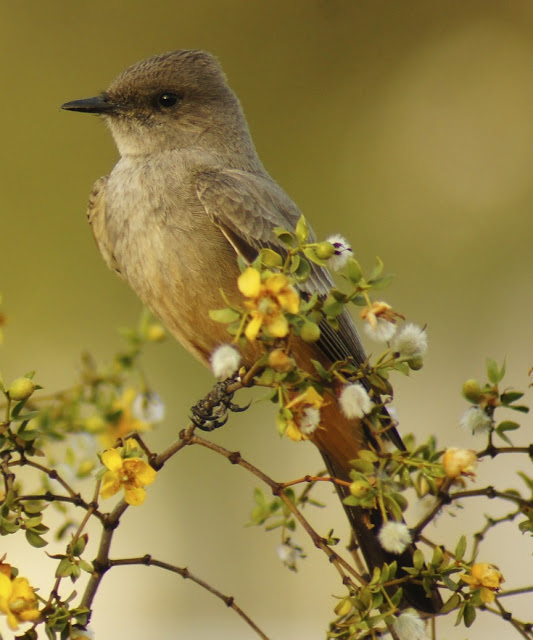In the 4 hour trip I'm estimating I covered maybe 5 miles of switch-backs, alleys, canals, waterways, and golf courses, and got to explore the behind-the-scenes lifelines of the Scottsdale greenery.
The trip was not a break-through photographically, but I did get to add a few birds to my List and have an adventure along the way.
I first encountered some Brewer's Sparrows as I descended into the basin of drainage ponds on the south side of the McCormick Ranch golf course.

They provided a better look than I had last week when I saw my first Brewer's Sparrows, and had actually and mistakenly used juvenile Chipping Sparrow pictures in their place.
While tromping around the marshes I saw the normal regimen of fall-feathered warblers (warblers in their ubiquitous yellow that I can't really identify, so I just say they're all Yellow Warblers) but was stunned to flush a Common Yellowthroat. This was only the third time I've seen a Common Yellowthroat, despite their name, and since I again failed to get a picture, I've now struck-out with the Yellowthroat and the Wilson's Warblers.
 |
| Here is another Yellow Warbler
I followed the water through an overpass and onto the McCormick golf course, where I was met with rather hostile looks from both the golfers and the resident waterfowl.
As one might expect, I saw both Great Blue Herons and Great Egrets pacing around the ponds, and also spotted an un-spotted Spotted Sandpiper busily running back and forth, as though it couldn't decide which bit of mud it wanted to examine first.
The spots only fill in as a part of the Sandpiper's breeding plumage.
I found a nice shady spot next to a weeping willow tree, which worked both for shade and as a bit of a shield against the wary ducks that stayed well out of camera range. I'm pretty sure there were Teals mixed in with the Mallards and Coots, and I did manage to photograph what may be a pair of female Pintails, since few other female ducks have the solidly gray beaks.
From the hidden vantage point, I also managed to get a good shot of a Chipping Sparrow, which I had
thus far been unable to photograph before they scampered.
I followed the golf course pods out through another underpass into a sort of shallow irrigation system that seemed to run behind lots of the nicer housing projects, and passed a couple of Flycatchers before entering into a more wooded area--the larger trees sinking their roots into the continuos water supply without fear of golf-course horticulture.
The McCormick Ranch waterways linked up to the Chaparral Park and golf courses waterways on a north/south route in between Scottsdale road and Hayden. Since the water syphons off to various communities along the way, the wildlife was much less present here, although I did come across a corn snake (?) and a Green Heron.
Look at him dipping his dainty toes in the water.
By time I hit Indian School Road, a good 3 miles or so south of where I started, it was time to turn around. The pond supply line also seemed ready to loop back, and it created a quaint little island that hosted a singular, massive cottonwood tree that must have entertained over a dozen Gila and Ladder-Backed Woodpeckers.
This neat water feature was running in between two neighborhoods. I don't know who put in the bridge, but it's an ideal picnic getaway now.
Unfortunately, I did not have my lunch with me, so I took the quickest route back to the McCormick Ranch spillway where I had parked.
I decided to double-check the drainage swamps near my car in case the Common Yellowthroat had returned. While there were no warblers to be found, I did stumble upon a ruffled Greater Roadrunner that was contentedly eating bees. He didn't seem to want to move at all, and I had to proceed through the weeds since he had squatter's rights.
Click on the image to enlarge and see the bee-in-mouth action!.
This continued my good record of photographing Roadrunners eating things, but the best was yet to come.
While circling the last pond before my car, I saw some subdues movement among the water weeds. A dark shape, maybe 7 inches long, was stirring about in the tulles. I was expecting a cowbird or a blackbird, but when I approached some sort of Rail flushed and flew across the pond.
I managed to circumnavigate and position myself behind the bird, and with some semi-satisfactory photos I managed to identify it as a Sora, another new bird!
It was a fun trip with some good moments. I can't say I'll do it again, since all in all I didn't see more birds than I would at some other designated birding area. However I was very happy to see the Sora and get a good picture of the Chipping Sparrow. It's nice to see the birds thriving among the city scapes. Wherever you go, there birds will be around you.
|





















